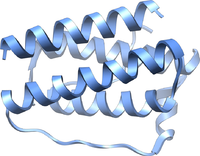
Photo from wikipedia
Perfusion-ventilation matching in the lungs requires AMPK-α1 and AMPK-α2 activation downstream of LKB1. Hypoxia amps AMPK Most arteries in the body vasodilate in response to hypoxia. In contrast, pulmonary arteries… Click to show full abstract
Perfusion-ventilation matching in the lungs requires AMPK-α1 and AMPK-α2 activation downstream of LKB1. Hypoxia amps AMPK Most arteries in the body vasodilate in response to hypoxia. In contrast, pulmonary arteries constrict in response to hypoxia to ensure that blood is diverted to oxygen-rich areas, a process called hypoxic pulmonary vasoconstriction. When this process is prolonged, it can lead to pulmonary hypertension and, ultimately, heart failure. Analysis of genetically manipulated mice by Moral-Sanz et al. showed that hypoxic pulmonary vasoconstriction under mild hypoxia required the α1 subunit of AMPK, which was activated downstream of LKB1 during hypoxia. During severe hypoxia, the α2 subunit of AMPK was also required. AMPK supports hypoxic pulmonary vasoconstriction, in part, by phosphorylating and inhibiting the K+ channel KV1.5 in pulmonary arterial myocytes. By contrast, in most systemic arteries, hypoxia does not inhibit KV, which may aid vasodilation rather than vasoconstriction. These results delineate a key role for LKB1-activated AMPK-α1 and AMPK-α2 in hypoxic pulmonary vasoconstriction. Hypoxic pulmonary vasoconstriction (HPV), which aids ventilation-perfusion matching in the lungs, is triggered by mechanisms intrinsic to pulmonary arterial smooth muscles. The unique sensitivity of these muscles to hypoxia is conferred by mitochondrial cytochrome c oxidase subunit 4 isoform 2, the inhibition of which has been proposed to trigger HPV through increased generation of mitochondrial reactive oxygen species. Contrary to this model, we have shown that the LKB1–AMPK-α1 signaling pathway is critical to HPV. Spectral Doppler ultrasound revealed that deletion of the AMPK-α1 catalytic subunit blocked HPV in mice during mild (8% O2) and severe (5% O2) hypoxia, whereas AMPK-α2 deletion attenuated HPV only during severe hypoxia. By contrast, neither of these genetic manipulations affected serotonin-induced reductions in pulmonary vascular flow. HPV was also attenuated by reduced expression of LKB1, a kinase that activates AMPK during energy stress, but not after deletion of CaMKK2, a kinase that activates AMPK in response to increases in cytoplasmic Ca2+. Fluorescence imaging of acutely isolated pulmonary arterial myocytes revealed that AMPK-α1 or AMPK-α2 deletion did not affect mitochondrial membrane potential during normoxia or hypoxia. However, deletion of AMPK-α1, but not of AMPK-α2, blocked hypoxia from inhibiting KV1.5, the classical “oxygen-sensing” K+ channel in pulmonary arterial myocytes. We conclude that LKB1–AMPK-α1 signaling pathways downstream of mitochondria are critical for the induction of HPV, in a manner also supported by AMPK-α2 during severe hypoxia.
Journal Title: Science Signaling
Year Published: 2018
Link to full text (if available)
Share on Social Media: Sign Up to like & get
recommendations!